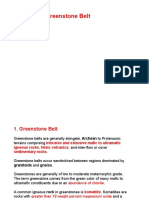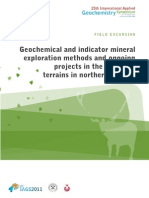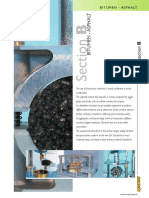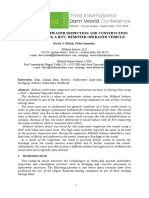Sediment Sampling - US EPA
Sediment Sampling - US EPA
Uploaded by
megacobCopyright:
Available Formats
Sediment Sampling - US EPA
Sediment Sampling - US EPA
Uploaded by
megacobCopyright
Available Formats
Share this document
Did you find this document useful?
Is this content inappropriate?
Copyright:
Available Formats
Sediment Sampling - US EPA
Sediment Sampling - US EPA
Uploaded by
megacobCopyright:
Available Formats
# 1215 Rev. 1 9/99 Pg.
1 of 10
U.S.EPA REGION 9 LABORATORY RICHMOND, CALIFORNIA
FIELD SAMPLING GUIDANCE DOCUMENT #1215
SEDIMENT SAMPLING
# 1215 Rev. 1 9/99 Pg. 2 of 10
TABLE OF CONTENTS 1.0 2.0 3.0 4.0 5.0 6.0 7.0 SCOPE AND APPLICATION METHOD SUMMARY SAMPLE PRESERVATION, CONTAINERS, HANDLING, AND STORAGE INTERFERENCES AND POTENTIAL PROBLEMS EQUIPMENT/APPARATUS REAGENTS PROCEDURES 7.1 7.2 7.2.1 7.2.2 7.2.3 7.2.4 7.2.5 8.0 9.0 10.0 11.0 PREPARATION SAMPLE COLLECTION Sampling Surface Sediments with a Trowel or Scoop from Beneath a shallow Aqueous Layer Sampling Surface Sediments with a Tin-Wall Tube Auger from Beneath a Shallow Aqueous Layer Sampling Deep Sediments with Augers and Thin-Wall Tube Samplers From Beneath a Shallow Aqueous Layer Sampling Surface Sediments from Beneath a Deep Aqueous Layer with an Eckman or Ponar Dredge Sampling Subsurface Sediments From Beneath a Deep Aqueous Layer with a Sample Coring Device
CALCULATIONS QUALITY ASSURANCE/QUALITY CONTROL DATA VALIDATION HEALTH AND SAFETY
# 1215 Rev. 1 9/99 Pg. 3 of 10
1.0
SCOPE AND APPLICATION
This Standard Operating Procedure (SOP) is applicable to the collection of representative sediment samples. Analysis of sediment may determine whether concentrations of specific contaminants exceed established threshold action levels, or if the concentrations present a risk to public health, welfare, or the environment. The methodologies discussed in this procedure are applicable to the sampling of sediment in both flowing and standing water. They are generic in nature and may be modified in whole or part to meet the handling and analytical requirements of the contaminants of concern, as well as the constraints presented by the sampling area. However, if modifications occur, they should be documented in the site logbook or report summarizing field activities. For the purposes of this procedure, sediments are those mineral and organic materials situated beneath an aqueous layer. The aqueous layer may be either static, as in lakes, ponds, or other impoundments or flowing, as in rivers and streams. 2.0 METHOD SUMMARY
Sediment samples may be recovered using a variety of methods and equipment, depending on the depth of the aqueous layer, the portion of the sediment profile required (surface versus subsurface), the type of sample required (disturbed versus undisturbed) and the sediment type. Sediment is collected from beneath an aqueous layer either directly, using a hand-held device such as a shovel, trowel, or auger, or indirectly using a remotely activated device such as an Eckman or Ponar dredge. Following collection, the sediment is placed into a container constructed of inert material, homogenized, and transferred to the appropriate sample containers. The homogenization procedure should not be used if sample analysis includes volatile organics. 3.0
C C
SAMPLE PRESERVATION, CONTAINERS, HANDLING, AND STORAGE Chemical preservation of solids is generally not recommended. Cooling is usually the best approach, supplemented by the appropriate holding time. Wide-mouth glass containers with Teflon-lined caps are utilized for sediment samples. The sample volume is a function of the analytical requirements and will be specified in the work plan. Transfer sediment from the sample collection device to an appropriate sample container using a stainless steel or plastic lab spoon or equivalent. If composite samples are collected, place the sediment sample in a stainless steel, plastic or other appropriate composition (e.g.: Teflon) bucket, and mix thoroughly to obtain a homogeneous sample representative of the entire sampling interval. Then place the sediment sample into labeled containers. Samples for volatile organic analysis must be collected directly from the bucket, before
# 1215 Rev. 1 9/99 Pg. 4 of 10
mixing the sample, to minimize loss due to volatilization of contaminants.
C
All sampling devices should be decontaminated, then wrapped in aluminum foil. The sampler should remain in this wrapping until it is needed. Each sampler should be used for only sample. Dedicated samplers for sediment samples may be impractical due to the large number of sediment samples which may be required and the cost of the sampler. In this case, samplers should be cleaned in the field using the decontamination procedure described in SOP#109, Sampling Equipment Decontamination. INTERFERENCES AND POTENTIAL PROBLEMS
4.0
Substrate particle size and organic content are directly related to water velocity and flow characteristics of a body of water. Contaminants are more likely to be concentrated in sediments typified by fine particle size and a high organic content. This type of sediment is most likely to be collected from depositional zones. In contrast, coarse sediments with low organic content do not typically concentrate pollutants and are found in erosional zones. The selection of a sampling location can, therefore, greatly influence the analytical results. 5.0 EQUIPMENT/APPARATUS
C C C C C C C C C C C C C C C C C C C C C C C C C
Equipment needed for collection of sediment samples includes: maps/plot plan safety equipment compass tape measure survey stakes, flags, or buoys and anchors camera and film stainless steel, plastic, or other appropriate composition bucket 4-oz, 8-oz, and one-quart, wide-mouth jars w/Teflon-lined lids Ziploc plastic bags logbook sample jar labels chain of custody forms, field data sheets cooler(s) ice decontamination supplies/equipment spade or shovel spatula scoop trowel bucket auger thin-walled auger extension rods T-handle sampling trier sediment coring device (tubes, points, drive head, drop hammer, eggshell check valve devices, acetate cores)
# 1215 Rev. 1 9/99 Pg. 5 of 10
C C C
Ponar dredge Eckman dredge nylon rope
6.0
REAGENTS
Reagents are not used for preservation of sediment samples. Decontamination solutions are specified in SOP #109, Sampling Equipment Decontamination. 7.0 7.1 PROCEDURES Preparation 1. 2. 3. 4. 5. 6. Determine the extent of the sampling effort, the sampling methods to be employed, and which equipment and supplies are required. Obtain necessary sampling and monitoring equipment. Decontaminate or preclean equipment, and ensure that it is in working order. Prepare schedules, and coordinate with staff, client, and regulatory agencies, if appropriate. Perform a general site survey prior to site entry in accordance with the site-specific health and safety plan. Use stakes, flags, or buoys to identify and mark all sampling locations. Specific site characteristics, including flow regime, basin morphometry, sediment characteristics, depth of overlying aqueous layer, and extent and nature of contaminant should be considered when selecting sample location. If required, the proposed locations may be adjusted based on site access, property boundaries, and surface obstructions.
7.2
Sample Collection
Selection of a sampling device is most often contingent upon: (1) depth of water at the sampling location, and (2) the physical characteristics of the medium to be sampled. 7.2.1 Sampling Surface Sediments with a Trowel or Scoop from Beneath a Shallow Aqueous Layer If the surface water body is wadeable, the easiest way to collect a sediment sample is by using a stainless steel scoop or spoon. The sampling method is accomplished by wading into the surface water body and while facing upstream (into the current), scooping the sample along the bottom of the surface water body in the upstream direction. Excess water may be removed from the scoop or spoon. However, this may result in the loss of some fine particle size material associated with the bottom of the surface water body. This method can be used to collect consolidated sediments but is limited somewhat by the depth of the aqueous layer. Accurate, representative samples can be collected with this procedure depending on the care and precision demonstrated by the sample team member. In surface water bodies that are too deep to wade, but less than eight feet deep, a stainless steel scoop or spoon attached to a piece of conduit can be used either from the banks if the surface water body is narrow or from a boat. The sediment is
# 1215 Rev. 1 9/99 Pg. 6 of 10
placed into a glass pan and homogenized. A stainless steel or plastic scoop or lab spoon will suffice in most applications. Care should be exercised to avoid the use of devices plated with chrome or other materials. Plating is particularly common with garden trowels. Follow these procedures to collect sediment samples with a scoop or trowel: 1. Using a precleaned stainless steel scoop or trowel, remove the desired thickness of sediment from the sampling area. 2. Transfer the sample into an appropriate sample or homogenization container. 7.2.2 Sampling Surface Sediments with a Thin-Wall Tube Auger from Beneath a Shallow Aqueous Layer This system consists of an auger, a series of extension rods, and a T handle. The auger is driven into the sediment and used to extract a core. A sample of the core is taken from the appropriate depth. Use the following procedure to collect sediment samples with a thin-walled auger: 1. Insert the auger into the material to be sampled at a 0o to 45o angle from vertical. This orientation minimizes spillage of the sample from the sampler. Extraction of samples may require tilting of the sampler. 2. Rotate the auger once or twice to cut a core of material. 3. Slowly withdraw the auger, making sure that the slot is facing upward. 4. An acetate core may be inserted into the auger prior to sampling, if characteristics of the sediments or body of water warrant. By using this technique, an intact core can be extracted. 5. Transfer the sample into an appropriate sample or homogenization container. 7.2.3 Sampling Deep Sediments with Augers and Thin-Wall Tube Samplers From Beneath a Shallow Aqueous Layer This system uses an auger, a series of extension rods, a T handle, and a thin-wall tube sampler. The auger bores a hole to a desired sampling depth and then is withdrawn. The auger tip is then replaced with a tube core sampler, lowered down the borehole, and driven into the sediment at the completion depth. The core is then withdrawn and the sample collected. This method can be used to collect consolidated sediments, but is somewhat limited by the depth of the aqueous layer. Several augers are available which include bucket and posthole augers. Bucket augers are better for direct sample recovery, are fast, and provide a large volume of sample. Posthole augers have limited utility for sample collection, as they are designed more for their ability to cut through fibrous, rooted, swampy areas. Follow these procedures to collect sediment samples with a hand auger: 1. Attach the auger bit to a drill extension rod, then attach the T handle to the drill
# 1215 Rev. 1 9/99 Pg. 7 of 10
2. 3. 4. 5. 6. 7. 8. 9. 10.
extension rod. Clear the area to be sampled of any surface debris. Begin augering, periodically removing any accumulated sediment from the auger bucket. After reaching the desired depth, slowly and carefully remove the auger from boring. (When sampling directly from the auger, collect sample after the auger is removed from boring and proceed to Step 10.) Remove auger tip from drill rods and replace with a precleaned thin-wall tube sampler. Install proper cutting tip. Carefully lower tube sampler down borehole. Gradually force tube sampler into sediment. Care should be taken to avoid scraping the borehole sides. Also avoid hammering of the drill rods to facilitate coring, since the vibrations may cause the boring walls to collapse. Remove tube sampler and unscrew drill rods. Remove cutting tip and remove core from device. Discard top of core (approximately 1 inch), as this represents material collected by the tube sampler before penetration of the layer of concern. Transfer sample into an appropriate sample or homogenization container.
7.2.4 Sampling Surface Sediments From Beneath a Deep Aqueous Layer with an Eckman or Ponar Dredge The Eckman dredge has only limited usefulness. It performs well where the bottom material is unusually soft, as when covered with organic sludge or light mud. It is unsuitable, however, for sandy, rocky, and hard bottoms and is too light for use in streams with high velocities. It should not be used from a bridge that is more than a few feet above the water, because the spring mechanism which activates the sampler can be damaged by the messenger if dropped from too great a height. Follow these procedures for collecting sediment with an Eckman dredge: 1. Thread a study nylon or stainless steel cable through the bracket, or secure the extended handle to the bracket with machine bolts. 2. Attach springs to both sides. Arrange the Ekman dredge sampler so that the jaws are in the open position and trip cables are positioned over the release studs. 3. Lower the sampler to a point just above the sediment surface. 4. Drop the sampler sharply onto the sediment. 5. Trigger the jaw release mechanism by lowering a messenger down the line, or by depressing the button on the upper end of the extended handle. 6. Raise the sampler and slowly decant any free liquid through the top of the sampler. Be careful to retain fine sediments 7. Open the dredge and transfer the sediment into a stainless steel or plastic bucket. Continue to collect additional sediment until sufficient material has been secured. Thoroughly mix sediment to obtain a homogeneous sample, and then transfer to the appropriate sample container. 8. Samples for volatile organic analysis must be collected directly from the bucket before mixing the sample to minimize volatilization of contaminants. The Ponar dredge has a modification yet it is similar in size and weight. It has been modified by the addition of side plates and a screen on the top of the sample compartment. The screen over the sample compartment permits water to pass through the sampler as it descends thus reducing turbulence around
# 1215 Rev. 1 9/99 Pg. 8 of 10
the dredge. The Ponar dredge is easily operated by one person in the same fashion as the Eckman dredge. Lower it slowly as it approaches bottom, since it can displace and miss fine particle size sediment if allowed to drop freely. The Ponar dredge is one of the most effective samplers for general use on all types of substrates. The "mini" Ponar dredge is a smaller, much lighter version of the Ponar dredge. It is used to collect smaller sample volumes when working in industrial tanks, lagoons, ponds, and shallow water bodies. It is a good device use when collecting sludge and sediment containing hazardous constituents because the size of the dredge makes it more amenable to field cleaning. Follow these procedures for collecting sediment with a Ponar dredge: 1. Attach a sturdy nylon or steel cable to the hook provided on top of the dredge. 2. Arrange the Ponar dredge sampler in the open position, setting the trip bar so the sampler remains open when lifted from the top. 3. Slowly lower the sampler to a point just above the sediment. 4. Drop the sampler sharply into the sediment, then pull sharply up on the line, thus releasing the trip bar and closing the dredge. 5. Raise the sampler to the surface and slowly decant any free liquid through the screens on top of the dredge. Be careful to retain fine sediments. 6. Open the dredge and transfer the sediment to a stainless steel or plastic bucket. Continue to collect additional sediment until sufficient material has been gained. Thoroughly mix sediment to obtain a homogeneous sample, and then transfer to the appropriate sample container. 7. Samples for volatile organic analysis must be collected directly from the bucket before mixing the sample to minimize volatilization of contaminants. 7.2.5 Sampling Subsurface Sediments from Beneath a Deep Aqueous Layer with a Sample Coring Device Core samplers are used to sample vertical columns of sediment. They are particularly useful when a historical picture of sediment deposition is desired since they preserve the sequential layering of the deposit, and when it is desirable to minimize the loss of material at the sediment-water interface. Many types of coring devices have been developed depending on the depth of water from which the sample is to be obtained, the nature of the bottom material, and the length of core to be collected. They vary from hand push tubes to weight or gravity driven devices. Coring devices are particularly useful in pollutant monitoring because turbulence created by descent through the water is minimal, thus the fines of the sediment-water interface are only minimally disturbed; the sample is withdrawn intact permitting the removal of only those layers of interest; core liners manufactured of glass or Teflon can be purchased, thus reducing possible sample contamination; and the samples are easily delivered to the lab for analysis in the tube in which they were collected. The disadvantage of coring devices is that a relatively small surface area and sample size is obtained often necessitating repetitive sampling in order to obtain the required amount of material for analysis.
# 1215 Rev. 1 9/99 Pg. 9 of 10
Follow these procedures when using a sample coring device to collect subsurface sediments. It consists of a coring device, handle, and acetate core utilized in the following procedure: 1. Assemble the coring device by inserting the acetate core into the sampling tube. 2. Insert the eggshell check valve mechanisms into the tip of the sampling tube with the convex surface positioned inside the acetate core. 3. Screw the coring point onto the tip of the sampling tube. 4. Screw the handle onto the upper end of the sampling tube and add extension rods as needed. 5. Place the sampler in a perpendicular position on the material to be sampled. 6. This sampler may be used with either a drive hammer for firm consolidated sediments, or a T handle for soft sediments. If the T handle is used, place downward pressure on the device until the desired depth is reached. Rotate the sample to shear off the core of the bottom, retrieve the device and proceed to Step 15. 7. If the drive hammer is selected, insert the tapered handle (drive head) of the drive hammer through the drive head. 8. With left hand holding the tube, drive the sampler into the material to the desired depth. Do not drive the tube further than the tip of the hammers guide. 9. Record the length of the tube that penetrated the sample material, and the number of blows required to obtain this depth. 10. Remove the drive hammer and fit the keyhole-like opening on the flat side of the hammer onto the drive head. In this position, the hammer serves as a handle for the sampler. 11. Rotate the sampler at least two revolutions to shear off the sample at the bottom. 12. Lower the sampler handle (hammer) until it just clears the two ear-like protrusions on the drive head, and rotate about 90o . 13. Withdraw the sampler by puling the handle (hammer) upwards and dislodging the hammer from the sampler. 14. Unscrew the coring point and remove the eggshell check valve. 15. Slide the acetate core out of the sampler tube. The acetate core may be capped at both ends. The sample may be used in this fashion, or the contents transferred to a stainless steel or plastic bucket and mixed thoroughly to obtain a homogeneous sample representative of the entire sampling interval. Samples for volatile organic analysis must be sub-sampled and collected directly from the core before mixing the sample to minimize volatilization of contaminants. 8.0 9.0 CALCULATIONS This section is not applicable to this SOP. QUALITY ASSURANCE/QUALITY CONTROL
There are no specific quality assurance activities which apply to the implementation of these procedures. However, the following QA/QC procedures apply: C All data must be documented on field data sheets or within site logbooks. C All instrumentation must be operated in accordance with operating instructions as supplied by the manufacturer, unless otherwise specified in the work plan. Equipment checkout and calibration activities must occur prior to sampling/operation, and they must be
# 1215 Rev. 1 9/99 Pg. 10 of 10
documented. 10.0 11.0 DATA VALIDATION This section is not applicable to this SOP. HEALTH AND SAFETY
When working with potentially hazardous materials, follow U.S. EPA, OSHA and specific health and safety procedures. More specifically, when sampling sediment from bodies of water containing known or suspected hazardous substances, adequate precautions must be taken to ensure the samplers safety. The team member collecting the sample should not get too close to the edge of the water, where bank failure may cause him or her to lose their balance. To prevent this, the person performing the sampling should be on a lifeline, and be wearing adequate protective equipment. If sampling from a vessel is necessary, implement appropriate protective measures.
You might also like
- Hydroman THY SeriesDocument12 pagesHydroman THY SeriesJason LeeNo ratings yet
- 1 PDFDocument8 pages1 PDFNealNo ratings yet
- Sediment SamplingDocument38 pagesSediment SamplingŔaɓiɳ ṨhtNo ratings yet
- 2 Regional Geology FinalDocument25 pages2 Regional Geology FinalRegina Efraim100% (1)
- Ian Thompson - A Critique of Valuation Methods For Exploration PropertiesDocument12 pagesIan Thompson - A Critique of Valuation Methods For Exploration PropertiesZhuu Ming Ang100% (1)
- Quensh Culvert Replacement Method Statement PDFDocument41 pagesQuensh Culvert Replacement Method Statement PDFSi NanNo ratings yet
- The Backacter: Transportation of Excavator Section Towards SlipwayDocument5 pagesThe Backacter: Transportation of Excavator Section Towards SlipwayAditi BazajNo ratings yet
- Statistical Evaluation of Geochemical Au Sample Quality : Ghana Mining Journal, Pp. 7 - 14Document8 pagesStatistical Evaluation of Geochemical Au Sample Quality : Ghana Mining Journal, Pp. 7 - 14ChristianKamisi100% (1)
- Ore Mineral ExplorationDocument28 pagesOre Mineral Explorationyesaya112No ratings yet
- VMS DepositDocument39 pagesVMS Depositrifky100% (1)
- How Do I Do That in QGIS PDFDocument61 pagesHow Do I Do That in QGIS PDFClay Junior Mathews RamirezNo ratings yet
- Resourcemodelling 1 ActheroDocument22 pagesResourcemodelling 1 ActheroAndy ParkNo ratings yet
- Corbett Controls To Low Sulphidation Epithermal Au AbDocument4 pagesCorbett Controls To Low Sulphidation Epithermal Au AbAriyanto WibowoNo ratings yet
- Prospecting Geochemistry2Document25 pagesProspecting Geochemistry2Azizul HakimNo ratings yet
- Stream Sediment GeochemistryDocument24 pagesStream Sediment GeochemistryJhon Silva CadenillasNo ratings yet
- Vatukoula Gold Mines - Annual Report 2011Document96 pagesVatukoula Gold Mines - Annual Report 2011Intelligentsiya HqNo ratings yet
- Classification of Mineral DepositsDocument4 pagesClassification of Mineral DepositsWill PalomoNo ratings yet
- Interpretation of Aeromagnetic Data Over Gboko Using Source Parameter Imaging and Analytical SignalDocument63 pagesInterpretation of Aeromagnetic Data Over Gboko Using Source Parameter Imaging and Analytical SignalHendro LaksonoNo ratings yet
- Ore DepositsDocument270 pagesOre Depositsdyet100% (1)
- Sediment-Hosted Copper Deposits ofDocument53 pagesSediment-Hosted Copper Deposits ofJHOEL_GEONo ratings yet
- Geochemical ProspectingDocument13 pagesGeochemical ProspectingAhmad Invaluable AdenijiNo ratings yet
- Structural Controls On An Orogenic Au SystemDocument26 pagesStructural Controls On An Orogenic Au SystemPaul Heriver Gonzales PalaciosNo ratings yet
- The Sme Guide For Reporting Exploration Results, Mineral Resources, and Mineral Reserves (The 2007 SME Guide)Document47 pagesThe Sme Guide For Reporting Exploration Results, Mineral Resources, and Mineral Reserves (The 2007 SME Guide)Zuhry DizzyNo ratings yet
- Block Size Selection in Mine Planning PDFDocument8 pagesBlock Size Selection in Mine Planning PDFuttamksrNo ratings yet
- Jorc Code Table 1 Pilivili 2018Document22 pagesJorc Code Table 1 Pilivili 2018Ferdinand SiahaanNo ratings yet
- Gold Deposits of The 15-Moz Ahafo South Camp, Sefwi Granite-Greenstone Belt, Ghana - Insights Into The Anatomy of An Orogenic Gold Plumbing SystemDocument26 pagesGold Deposits of The 15-Moz Ahafo South Camp, Sefwi Granite-Greenstone Belt, Ghana - Insights Into The Anatomy of An Orogenic Gold Plumbing SystemAlejandro MedranoNo ratings yet
- Pyrite and Pyrrhotite Textures and Composition in Sediments, Laminated Quartz VeinsDocument31 pagesPyrite and Pyrrhotite Textures and Composition in Sediments, Laminated Quartz VeinsMaria Alejandra Suarez GarciaNo ratings yet
- Extensional Fault Arrays in Strike-Slip and Transtension: John W.F. WaldronDocument12 pagesExtensional Fault Arrays in Strike-Slip and Transtension: John W.F. WaldronIvan Hagler Becerra VasquezNo ratings yet
- Greenstone and BIFDocument74 pagesGreenstone and BIFtiago_maiaNo ratings yet
- OP or Block CavingDocument18 pagesOP or Block Cavingalvaroaac4No ratings yet
- MarioERossi and ClaytonVDeutsh - Mineral Resource Estimation-62-76Document15 pagesMarioERossi and ClaytonVDeutsh - Mineral Resource Estimation-62-76ArielEstebanZúñigaSanMartín100% (1)
- Nature of Basins in GhanaDocument4 pagesNature of Basins in GhanaAcheampong SamuelNo ratings yet
- MINE 395 - Mineral Deposit Modeling: Chapter 1: Mineral Inventory - An OverviewDocument8 pagesMINE 395 - Mineral Deposit Modeling: Chapter 1: Mineral Inventory - An Overviewlulu242008No ratings yet
- Basic Techniques of Mineral ExplorationDocument18 pagesBasic Techniques of Mineral ExplorationMd Habib100% (1)
- 11-QAQC Insertion Rate-Is There An Industry Standard-V6.5Document22 pages11-QAQC Insertion Rate-Is There An Industry Standard-V6.5mzecenarroNo ratings yet
- Greenstone-Hosted Quartz-Carbonate Vein Deposits (Orogenic, Mesothermal, LodeDocument13 pagesGreenstone-Hosted Quartz-Carbonate Vein Deposits (Orogenic, Mesothermal, LodeCarlos Gallego100% (4)
- Productivity in Platinum Mining: A Continuing Programme of Successful Development in Underground MechanisationDocument6 pagesProductivity in Platinum Mining: A Continuing Programme of Successful Development in Underground Mechanisationakshay sewcharanNo ratings yet
- Spectral In-House Training at CET: 1 March 2010Document22 pagesSpectral In-House Training at CET: 1 March 2010Regina EfraimNo ratings yet
- Geochem 25thIAGS2011 E5 NetDocument72 pagesGeochem 25thIAGS2011 E5 Netdayyoos56No ratings yet
- 16 JORC Mineral Resources ClasificationsDocument5 pages16 JORC Mineral Resources ClasificationsDiego SarmientoNo ratings yet
- Economic Geology: Matalliferous MaterialDocument9 pagesEconomic Geology: Matalliferous MaterialJameel JameelNo ratings yet
- Nomenclature, Concepts and Classification of Oreshoots in Vein DepositsDocument20 pagesNomenclature, Concepts and Classification of Oreshoots in Vein DepositsAngel Salas Colca100% (3)
- Geologic TimeDocument4 pagesGeologic TimeMuralikrishnaNo ratings yet
- Lecture 1 MetallicDocument95 pagesLecture 1 MetallicAbdulahmed Muhsin100% (1)
- 4.6 ClassificationDocument37 pages4.6 ClassificationGianncarlo Zamora100% (1)
- 7G - Regolith Mapping - FEB2014 - PRINT (Read-Only)Document24 pages7G - Regolith Mapping - FEB2014 - PRINT (Read-Only)Mar IoNo ratings yet
- Nugget Effect Artificial or NaturalDocument7 pagesNugget Effect Artificial or Naturalcapitan_barboza100% (1)
- Geology and Resource Estimation Hatta and ShinasDocument57 pagesGeology and Resource Estimation Hatta and ShinasRozalia PengoNo ratings yet
- Deep-Level Gold and Platinum Mining: Michael Van Schoor Zamaswazi Nkosi Fleckson Magweregwede Thabang KgarumeDocument80 pagesDeep-Level Gold and Platinum Mining: Michael Van Schoor Zamaswazi Nkosi Fleckson Magweregwede Thabang Kgarumekwkauffmann100% (1)
- The Interpretation of Geochemical Survey DataDocument49 pagesThe Interpretation of Geochemical Survey DataJhony Wilson Vargas BarbozaNo ratings yet
- 10 LagatDocument26 pages10 LagatKing Abdul AzizNo ratings yet
- CIM Resource Reserve DefintionsDocument26 pagesCIM Resource Reserve Defintionsederson2012No ratings yet
- Remote Sensing Technologies in Oil and Gas IndustryDocument33 pagesRemote Sensing Technologies in Oil and Gas IndustryMarselinus Satrio WicaksonoNo ratings yet
- Thogeochemistry & Gold Lithogeochemistry & Gold - Prendergast KylieDocument32 pagesThogeochemistry & Gold Lithogeochemistry & Gold - Prendergast KylieYuri Vladimir Ordonez LamaNo ratings yet
- Guinea Guilengbe Gold Initiative Proposal - Draft - 30dec2019Document8 pagesGuinea Guilengbe Gold Initiative Proposal - Draft - 30dec2019Sam DeclaroNo ratings yet
- Classification of OresDocument11 pagesClassification of OresDr R Vishwanath100% (1)
- Newmont Exploration GeochemistryDocument7 pagesNewmont Exploration GeochemistryMauridi Kaminyu100% (2)
- 34DGeomodelingAppliedtoMineralExploration PDFDocument5 pages34DGeomodelingAppliedtoMineralExploration PDFhamzasalhiNo ratings yet
- Sánchez - Lobo - 2018 - Guidebook of Good Environmental Practices For The Quarrying of Limestone in Karst AreasDocument267 pagesSánchez - Lobo - 2018 - Guidebook of Good Environmental Practices For The Quarrying of Limestone in Karst AreasAllan CaluxNo ratings yet
- GrovesOrogenicGold PDFDocument21 pagesGrovesOrogenicGold PDFBerthing Herrera100% (1)
- Atlas of Structural Geological Interpretation from Seismic ImagesFrom EverandAtlas of Structural Geological Interpretation from Seismic ImagesAchyuta Ayan MisraNo ratings yet
- Mining Capital: Methods, Best-Practices and Case Studies for Financing Mining ProjectsFrom EverandMining Capital: Methods, Best-Practices and Case Studies for Financing Mining ProjectsNo ratings yet
- Hitachi U-4100 BrochureDocument7 pagesHitachi U-4100 BrochuremegacobNo ratings yet
- Dacell Dn-10w, Dn-15w, Dn-20w SpecDocument1 pageDacell Dn-10w, Dn-15w, Dn-20w SpecmegacobNo ratings yet
- Dacell DN-10W, DN-20W, DN-25W, DN-30W, DN-50W Digital Indicator ManualDocument39 pagesDacell DN-10W, DN-20W, DN-25W, DN-30W, DN-50W Digital Indicator ManualmegacobNo ratings yet
- Matest Catalogue 4 Bitumen AsphaltDocument82 pagesMatest Catalogue 4 Bitumen AsphaltmegacobNo ratings yet
- Hitachi U-4100 Brochure Optical PartsDocument11 pagesHitachi U-4100 Brochure Optical PartsmegacobNo ratings yet
- Matest Catalogues PDFDocument528 pagesMatest Catalogues PDFmegacobNo ratings yet
- Chemical Fact File: Dust: Respirable, Particulates Not Otherwise Regulated - NIOSH 0600Document1 pageChemical Fact File: Dust: Respirable, Particulates Not Otherwise Regulated - NIOSH 0600megacobNo ratings yet
- Brookfield Ametek Thermosel Accessory: Manual No. M94-204-L0416Document25 pagesBrookfield Ametek Thermosel Accessory: Manual No. M94-204-L0416megacobNo ratings yet
- Brookfield Ametek Thermosel Accessory: Manual No. M94-204-L0416Document25 pagesBrookfield Ametek Thermosel Accessory: Manual No. M94-204-L0416megacobNo ratings yet
- Gardco ASTM ThermometersDocument15 pagesGardco ASTM ThermometersmegacobNo ratings yet
- HG ASTM ThermometersDocument4 pagesHG ASTM ThermometersmegacobNo ratings yet
- Cannon CT-1000 Installation and Operation ManualDocument30 pagesCannon CT-1000 Installation and Operation ManualmegacobNo ratings yet
- Instruction & Operation Manual: Digital Vacuum RegulatorDocument38 pagesInstruction & Operation Manual: Digital Vacuum RegulatormegacobNo ratings yet
- Kyoritsu 2431 - IM - 92-1470A - E - LDocument2 pagesKyoritsu 2431 - IM - 92-1470A - E - LmegacobNo ratings yet
- Digital PenetrometerDocument1 pageDigital PenetrometermegacobNo ratings yet
- Direct Reading Particulate Monitor and Air Station: Contact UsDocument2 pagesDirect Reading Particulate Monitor and Air Station: Contact UsmegacobNo ratings yet
- Dust Analyzer Meters: Product code: HHPC - 2 (0.5 μm)Document1 pageDust Analyzer Meters: Product code: HHPC - 2 (0.5 μm)megacobNo ratings yet
- TCGRX ATP2 SellSheetDocument2 pagesTCGRX ATP2 SellSheetmegacobNo ratings yet
- Guide To ATP For Road Hauliers and Manufacturers: March 2017Document17 pagesGuide To ATP For Road Hauliers and Manufacturers: March 2017megacobNo ratings yet
- Sci Guide To ATP Monitoring 2Document35 pagesSci Guide To ATP Monitoring 2megacob100% (1)
- Safety Data Sheet: HI 93733A-0 Nessler ReagentDocument5 pagesSafety Data Sheet: HI 93733A-0 Nessler ReagentmegacobNo ratings yet
- Sound Level Meter: IEC 61672 Class 2Document2 pagesSound Level Meter: IEC 61672 Class 2megacobNo ratings yet
- Selection Guide of Clamp Meters: 2200 2200R 2002PA 2002R 2204R 2210R AC Clamp Meters ModelDocument3 pagesSelection Guide of Clamp Meters: 2200 2200R 2002PA 2002R 2204R 2210R AC Clamp Meters ModelmegacobNo ratings yet
- Sound Level Meter: Model: SL-4010Document2 pagesSound Level Meter: Model: SL-4010megacobNo ratings yet
- HI 96733C Ammonia High Range ISM: Instruction ManualDocument13 pagesHI 96733C Ammonia High Range ISM: Instruction ManualmegacobNo ratings yet
- Safety Data Sheet: HI 93733B-0 Ammonia ReagentDocument3 pagesSafety Data Sheet: HI 93733B-0 Ammonia ReagentmegacobNo ratings yet
- Sound Level Meter With Auto-Range and Rs-232C: Lutron SL-4012Document2 pagesSound Level Meter With Auto-Range and Rs-232C: Lutron SL-4012megacobNo ratings yet
- Sound Level Meter: Model: SL-4022Document2 pagesSound Level Meter: Model: SL-4022megacobNo ratings yet
- Dredging StudyDocument83 pagesDredging StudyCarlos PicalugaNo ratings yet
- Thesis ProposalDocument12 pagesThesis ProposalsmarykyneNo ratings yet
- Electric Cutter Suction DredgerDocument2 pagesElectric Cutter Suction DredgerMohamed Elsayed100% (1)
- 01 Final NHH Ifr Eis February2020signedDocument213 pages01 Final NHH Ifr Eis February2020signedEditor, Hartford CourantNo ratings yet
- NTU-JTC I3C Seminar (02!8!2012) SlidesDocument24 pagesNTU-JTC I3C Seminar (02!8!2012) SlidesChua Chim HueeNo ratings yet
- Robotic Underwater Inspection and Construction Services Using A Rov-Remoted Operated VehicleDocument10 pagesRobotic Underwater Inspection and Construction Services Using A Rov-Remoted Operated VehicleMarcelo ProtzNo ratings yet
- Japan Dredging and Reclamation Engineering Association: WWW - Umeshunkyo.or - JPDocument8 pagesJapan Dredging and Reclamation Engineering Association: WWW - Umeshunkyo.or - JPthauwui860% (1)
- Suez Canal FinalDocument62 pagesSuez Canal Finaladam100% (1)
- Curriculum Vitae RamakrishnaDocument5 pagesCurriculum Vitae RamakrishnaRama KrishnaNo ratings yet
- Terra: International Association of Dredging CompaniesDocument40 pagesTerra: International Association of Dredging CompaniesgabionsNo ratings yet
- Dredging Port of Currimao (PMO Northern Luzon)Document2 pagesDredging Port of Currimao (PMO Northern Luzon)Jun KhoNo ratings yet
- CausewayDocument79 pagesCausewayeddieNo ratings yet
- IMS Dredges - DM-60 Specifications - 2014Document2 pagesIMS Dredges - DM-60 Specifications - 2014Mohamed ZaghloulNo ratings yet
- On The Statement of Gov. Ryan Singson Re: Blacksand MiningDocument2 pagesOn The Statement of Gov. Ryan Singson Re: Blacksand MiningDefend IlocosNo ratings yet
- Chapter 5project DescriptionDocument36 pagesChapter 5project Descriptionksg9731No ratings yet
- Workshop 2: Harbour Geotechnics: 3 International Conference On Transportation GeotechnicsDocument46 pagesWorkshop 2: Harbour Geotechnics: 3 International Conference On Transportation GeotechnicsEngwarwickNo ratings yet
- Artificial Island: SDM College of Engineering and Technology, Dhavalagiri, DharwadDocument17 pagesArtificial Island: SDM College of Engineering and Technology, Dhavalagiri, DharwadYogesh KhanapurNo ratings yet
- AHEP CEMD Chapter 7 Dredging & Dredge Spoil Disposal Management Plan RedactedDocument53 pagesAHEP CEMD Chapter 7 Dredging & Dredge Spoil Disposal Management Plan RedactedOrxan TalibzadeNo ratings yet
- Paper ICET 2017 Ruddy Yusuf, Onny Gondokusumo Rev.02Document10 pagesPaper ICET 2017 Ruddy Yusuf, Onny Gondokusumo Rev.02R3MB0No ratings yet
- Vessel Album, RO PatnaDocument32 pagesVessel Album, RO PatnaAishani BhattacharyaNo ratings yet
- Shore Protection Manual - Vol-II - US Army - 1984Document300 pagesShore Protection Manual - Vol-II - US Army - 1984hihappy2cuNo ratings yet
- DOC-20221113-WA0003 - WTP CulvertDocument4 pagesDOC-20221113-WA0003 - WTP CulvertFoisulAlamNo ratings yet
- A Wide Range of High Quality Pumps and Pumpsets Available FromDocument2 pagesA Wide Range of High Quality Pumps and Pumpsets Available FromYousef AlipourNo ratings yet
- Trailing Suction Hopper DredgerDocument109 pagesTrailing Suction Hopper Dredgerldaels100% (3)
- Frigg R: Nordic MythologyDocument2 pagesFrigg R: Nordic MythologyAnonyNo ratings yet
- 2023-BRL-05-XX-SP-C-1009 - D&R Specification - T03Document33 pages2023-BRL-05-XX-SP-C-1009 - D&R Specification - T03François Le RouxNo ratings yet




















































































































